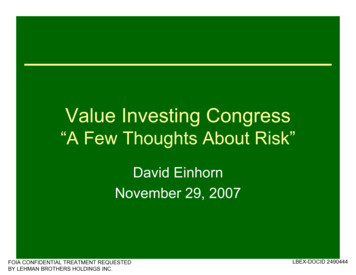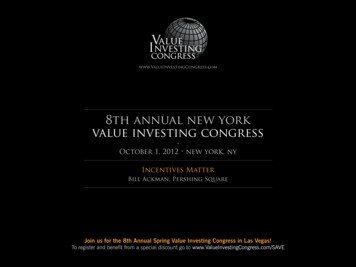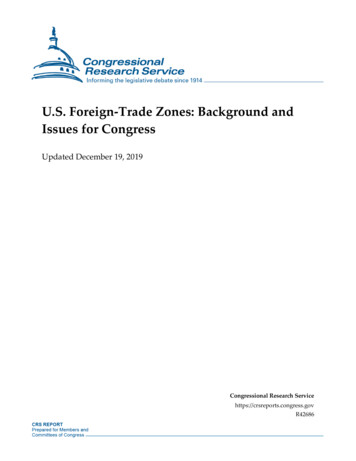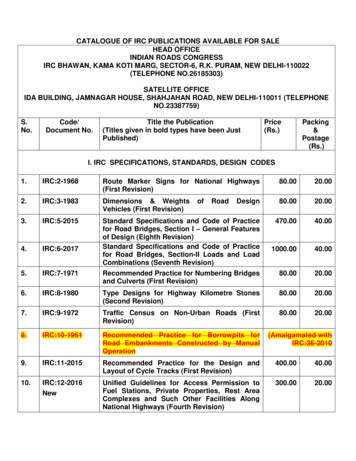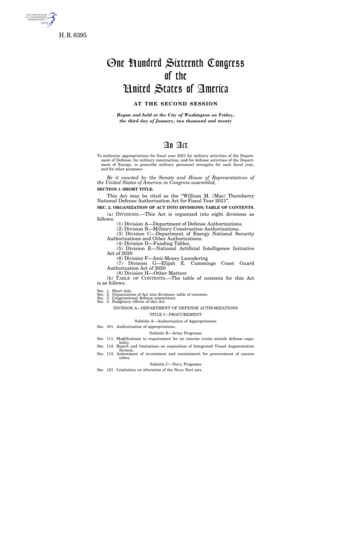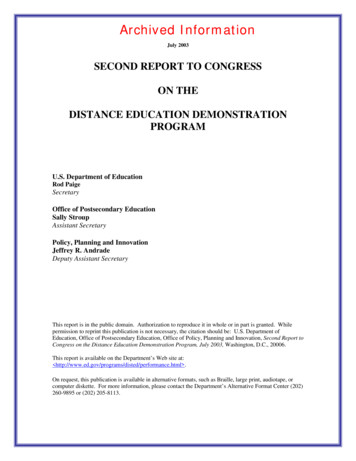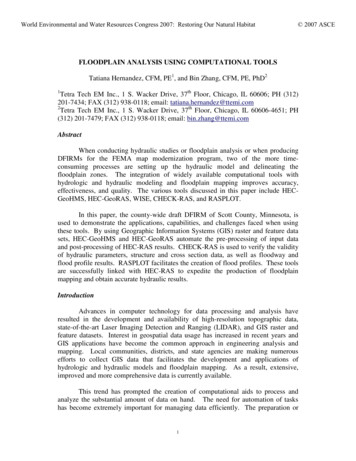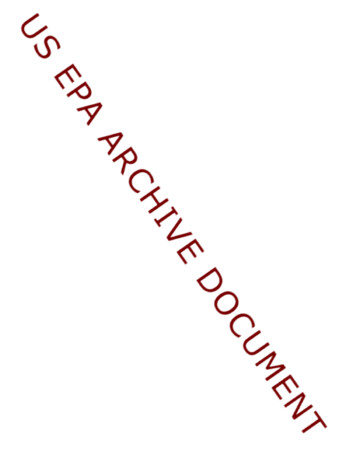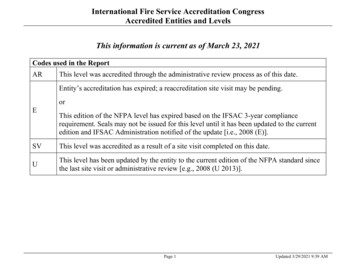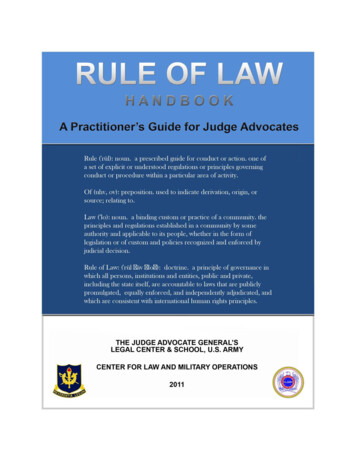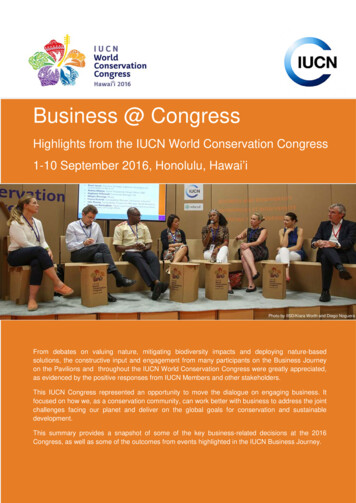
Transcription
Business @ CongressHighlights from the IUCN World Conservation Congress1-10 September 2016, Honolulu, Hawai’iPhoto by IISD/Kiara Worth and Diego NogueraFrom debates on valuing nature, mitigating biodiversity impacts and deploying nature-basedsolutions, the constructive input and engagement from many participants on the Business Journeyon the Pavilions and throughout the IUCN World Conservation Congress were greatly appreciated,as evidenced by the positive responses from IUCN Members and other stakeholders.This IUCN Congress represented an opportunity to move the dialogue on engaging business. Itfocused on how we, as a conservation community, can work better with business to address the jointchallenges facing our planet and deliver on the global goals for conservation and sustainabledevelopment.This summary provides a snapshot of some of the key business-related decisions at the 2016Congress, as well as some of the outcomes from events highlighted in the IUCN Business Journey.
The IUCN Conservation Congress 2016Held once every four years, the IUCN World Conservation Congress brings togetherthousands of leaders and decision-makers from government, civil society, indigenouscommunities, business and academia, with the goal of conserving the environment andharnessing the solutions nature offers to meet our pressing global challenges.During the 2016 Congress held in Honolulu, Hawaii, from 1-10 September 2016, over 10,000people from 190 countries participated. Of these, approximately 250 participants were fromthe private sector, including 100 representatives of 40 multi-national companies,representing a diverse range of sectors, including: agri-business, banking, insurance andfinance, consumer goods, extractives, energy, infrastructure, information technology,professional services, tourism and transportation.The two main components of the Congress are: The Forum (2-5 September) hosted more than 1,300 events – from high-leveldialogues and training workshops, to knowledge cafes and pavilion panel discussions– 117 of which addressed the theme of business. The Business and BiodiversityPavilion, co-funded by World Business Council for Sustainable Development(WBCSD), served as a hub for business and participants interested in businessrelated issues. The B Team sponsored special breakfast briefings with interviews andinsights from business experts, and reflected on key learnings from the previous dayas well as looking ahead to key events coming up. The Members’ Assembly (6-10 September), IUCN’s highest decision-making body,met to take joint decisions on proposed motions concerning biodiversity conservationand sustainable development. For the first time, WBCSD (IUCN’s only globalMember representing business) participated in the deliberations. Overall, theMembers’ Assembly addressed 105 motions and 85 of these were voted on prior toCongress via electronic vote – another first -- while the remaining motions weretabled and debated during the Assembly.Planet at the CrossroadsThe theme of the IUCN Congress, Planet at the Crossroads, drew attention to the perilousstate of the world’s biodiversity, and the critical role nature’s ecosystems play inunderpinning our economies, well-being and survival. The success of the ambitious globalgoals for sustainable development and climate neutrality depend on how quickly we adoptmore sustainable, nature-based solutions.Therefore, business as usual is not an option.“We need to bring the initiativesof all stakeholders together inNature conservation and human progress areone coherent flow No task isnot mutually exclusive – they are inextricablytoo big if we act together.”linked. Moving forward, we need to createErik Solheim, Executive Director,credible and viable alternatives for business.United Nations EnvironmentThis includes supporting new partnershipsProgramme (UNEP)betweengovernments,NGOs,Business @ IUCN Congress highlights 1-10 Sep 20162
conservationists, scientists, consumers, ganisations, indigenous peoples and the financialcommunity. Each partner holds a vital piece of thepuzzle – the knowledge, the tools and resources –needed to build a more inclusive and sustainablefuture.“The main users ofbiodiversity are businesses."Braulio Dias, ExecutiveSecretary, CBD.The role of business in implementing conservation goalsThe IUCN Global Programme 2017-2020, adopted at Congress, offers a pathway for actionto addressing the world’s sustainable development goals. The Business Journey was framedaround the structure of the IUCN Global Programme and highlighted events thatdemonstrate the role of business in:1.2.3.4.Valuing natureManaging biodiversity impactsContributing to effective and equitable governance of nature’s use.Investing in nature-based solutions.These thematic areas also shaped the Business and Biodiversity Pavilion schedule.Valuing natureNatural capital approaches were a major topic ofdebate throughout Congress, where differing views ofIUCN Members were expressed.The complexity of valuing ecosystem goods andservices in the context of business impacts anddependencies was highlighted as well as the need toconsider other types of value (i.e. spiritual, social,cultural) that cannot be monetized.During the IUCN Members’ Assembly, it was decidedthat IUCN will work on developing a natural capitalpolicy that reconciles these diverging views. Bringing Business on Board: New ProtocolUnveiled at IUCN Congress (Blog by IUCN’sGerard Bos in the Huffington Post) From companies to communities: IUCNCongress explores natural capital approachesand impacts (web story)Business @ IUCN Congress highlights 1-10 Sep 2016“The conservation communityand business speak differentlanguages. The NaturalCapital Protocol is thelanguage bridge betweenbusiness and conservation."Peter Bakker, CEO, WBCSD“We can no longer afford toprivatize the gains ofimpacting ecosystems, whilesocializing the losses.”Thomas Friedman, author andcolumnist for the New YorkTimes.3
Figure: The illustration above reflects the discussions exploring various natural capital approaches. For highresolution and other images, see http://www.designbyleah.com/Managing impacts on biodiversityUnder this theme, participants explored through advances in the mitigation hierarchy(including avoidance, minimization, restoration and biodiversity offsets), aiming towards abiodiversity net gain. One major success was the approval of the first global policy onbiodiversity offsets, which was the result of a two-year consultation process. Further information on biodiversityoffsets including links to the policyprocess and new Issues Brief (webpage)“The process used for thedevelopment of the biodiversityoffset policy was an exemplarydemonstration of the OneProgramme approach in IUCN”.Aroha Mead, outgoing Chair of theIUCN Commission on Economic,Environmental and Social PolicyA new report highlighting the value of IUCN-ledIndependent Scientific Advisory and TechnicalPanels (ISTAPS) received broad support fromcivil society, business and government.The report, Western Grey Whale AdvisoryPanel: Stories of Influence, launched at a pressconference with representatives from IUCN,WWF, IFAW, WGWAP and Shell at Congress, received more than 200 mentions in themedia. IUCN panel finds critically endangered whales in Russia recovering, but warnsindustry still poses threat (global press release in English. Also available in French,Spanish and Russian)Another IUCN publication released at Congress underscored the benefits of scientificcollaboration with business. Drawing on WGWAP’s experience with the oil and gas industry,IUCN released new guidelines for conducting seismic surveys and other forms of underwatergeophysical mapping.Business @ IUCN Congress highlights 1-10 Sep 20164
Turn down the volume: New IUCN guide helps navigate seismic survey impacts onmarine speciesAlso, the IUCN Commission on Environmental, Economic and Social Policy (CEESPlaunched the latest edition of Policy Matters, which finds that comprehensive assessmentsare required for voluntary certification standards to have a real impact on nature andlivelihoods. New IUCN publication examines pros and cons of voluntary certification standards onnature and livelihoods (Congress web story)Contributing to effective and equitable governance of nature’s useThe theme of natural resource use governance was addressed from a business perspectivethrough the role of business in two complementary areas: integration of stakeholder valuesin decision-making and multi-stakeholder collaboration.A number of events addressed directly or indirectlymulti-stakeholder collaboration, including the needto build on bilateral partnerships to scale up andcause change at scale across sectors by buildingtrust and developing a common language. An urgent call for collaborative action at theIUCN Congress: A blog by ICMM CEO TomButler (Congress blog)“Climate change is achallenge for both societyand industry.” Tom Butler,CEO, International Council onMining and Metals, at the highlevel dialogue on climatechange.Several sessions also explored how to manage conflict with business including the need fora rights-based framework, compliance and dialogue, bringing together stakeholders togetherin norm-setting.Investing in nature-based solutionsNature-based solutions are actions to protect, sustainably manage and restore natural ormodified ecosystems, which address societal challenges (e.g. climate change, food andwater security or natural disasters) effectively and adaptively, while simultaneously providinghuman well-being and biodiversity tered on restoration, protection and natural nt is an important aspect that featuredacross many sessions and on different pavilions.Indeed, the World Bank and the IFC recognized theneed to be working more closely with otherstakeholders through landscape-based approaches. “Language is important: weneed to talk about mutualgain instead of compromise.”Susan Fernandes, US BCSDSUSTAIN-Africa: Driving green growth at a landscape level (Congress web story)Business @ IUCN Congress highlights 1-10 Sep 20165
One of the key themes, conservation finance was thesubject of a high level dialogue, which also announcedthe launch of a collation for scaling private investment intoconservation support by 26 different organizations andnetworks. New coalition launches to scale privateconservation investmentatIUCN WorldConservation Congress (global press release)“The only way to doconservation at scale isthrough collaboration.”Morgan Landy, VP at theIFCIUCN resolution discussions relevant for businessOf the 105 resolutions and recommendations adopted by the IUCN Members at theCongress, 30 are directly relevant to business. Some call upon business in general, whileothers target specific sectors.A number of resolutions will help business across a range of sectors to select areas fordevelopment and avoid loss of biodiversity, including resolutions on “Protected areas andother areas important for biodiversity in relation to environmentally damaging industrialactivities and infrastructure development”, “Identifying Key Biodiversity Areas forsafeguarding biodiversity”, “Avoiding extinction in limestone karst areas” and “Protection ofprimary forests, including intact forest landscapes”.Another set of resolutions focus on best practices and tools recommended for business.Among these: “IUCN Policy on Biodiversity Offsets”, “Natural Capital”, “Improving standardsin ecotourism”, “Strengthening business engagement in biodiversity preservation”,“Strengthening corporate biodiversity measurement, valuation and reporting”, “Best practicefor industrial-scale development projects”, and “Prevention, management and resolution ofsocial conflict as a key requirement for conservation and management of ecosystems”.Responding to one of today’s environmental crisis, “Promoting regional approaches to tacklethe global problem of marine debris (litter)” calls upon key stakeholders to take strongmeasures to tackle this problem, including the private sector.More specifically, the resolution on “Preventing electrocution and collision impacts of powerinfrastructure on birds” calls upon the power sector specifically. Other resolutions on“Management and regulation of selective intensive breeding of large wild mammals forcommercial purposes”, “Terminating the hunting of captive-bred lions (Panthera leo) andother predators and captive breeding for commercial, non-conservation purposes”, and “Apath forward to address concerns over the use of lead ammunition in hunting” focusspecifically on the trophy hunting sector.Finally, among the approved changes to IUCN’s Statutes, IUCN Members voted in favour ofcreating a new membership category for Indigenous Peoples organizations.Business @ IUCN Congress highlights 1-10 Sep 20166
Business engagement identified as key solution in Hawai’iCommitmentsOne of the main outcomes from the Congress are The Hawai’i Commitments, which identifybusiness engagement as one of the five key solutions for “Addressing the Challenges of aPlanet at the Crossroads,” and ultimately, delivering on the global Sustainable DevelopmentGoals. In particular, the section on engaging the private sector states:"There is a palpable and urgent need to significantly increase investment inconservation action from both public and private sector sources. A preconditionfor attracting private investment is that conservation opportunities exist at scale.Additionally, regulatory and policy regimes that create a level playing field forbusiness operations and that incentivize private investment to promoteconservation are necessary. Ultimately, a collaborative approach, includinggovernment, civil society and the private sector, is essential for success."Other solutions, also requiring business engagement, are focused on addressing
IUCN Congress: A blog by ICMM CEO Tom Butler (Congress blog) Several sessions also explored how to manage conflict with business including the need for a rights-based framework, compliance and dialogue, bringing together stakeholders together in norm-setting. Investing in nature-based solutions
